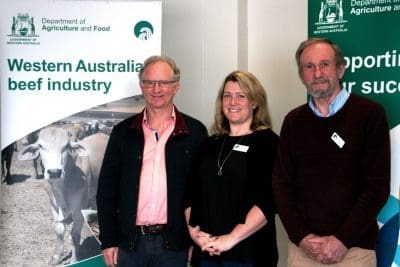
WA Cattle Industry Management Committee chair Steve Meerwald (left), WA Acting Chief Veterinary Officer Dr Mia Carbon and Animal Disease Control project manager Dr Bob Vassallo.
An extensive testing program for bovine Johne’s disease (BJD) has cleared the last of six Kimberley properties that had received bulls from a Queensland herd infected with BJD.
The testing was conducted by the Department of Agriculture and Food and funded through the cattle Industry Funding Scheme.
In a statement today, WA Acting Chief Veterinary Officer Mia Carbon commended the WA industry for its leadership and support of the surveillance undertaken to maintain WA’s BJD status.
“In December 2012, 448 bulls from a BJD-infected herd in Queensland were traced to six Kimberley properties,” Dr Carbon said.
“The properties were quarantined to manage potential risks to the WA cattle herd.
“One property that had received a single bull was released from quarantine following identification, slaughter and negative testing of that bull.
“Not all bulls were able to be located on the remaining five properties, so two rounds of herd testing were carried out to provide confidence that these properties were free from BJD.
“Three properties were released during 2015 and a fourth property was released in May 2016 following completion of two rounds of negative testing. The final property was released on 16 August.”
Dr Carbon said DAFWA worked with affected producers throughout the investigations to minimise the impact of restrictions.
The Australian cattle industry has now endorsed the new national BJD Framework, which from 1 July deregulated BJD management and changed the focus nationally to a market assurance system similar to those in place for other endemic diseases.
“This means that zoning for BJD no longer exists at a national level and so Western Australia can no longer be called a ‘free zone’,” Dr Carbon said.
“The WA industry is keen to maintain WA’s negligible BJD prevalence by not importing cattle with a lower BJD status, and DAFWA has supported this by introducing interim BJD border controls from 1 July.
“These controls will be reviewed and a long-term plan implemented by the WA industry through the cattle Industry Funding Scheme following consideration of the management tools available and the potential costs and benefits of control options.”
Source: DAFWA, More information on the new BJD framework and import conditions for stock movement into WA is available at agric.wa.gov.au



Does this mean WA cattlemen won’t be buying cattle from WA properties that co -graze sheep and cattle,particularly where there is known OJD (JD) infection in the sheep flock ?
WA has had no surveilance testing for twelve years,while co grazing infected sheep with cattle ! I would say WA status in unknown at best and more likely a level of infection higher than Queensland because of your infected sheep flock !
So get with the program WA ! The rest of the world is leaving you behind as far as JD management is concerned and save your cattle producers a lot of unnessesary pain !